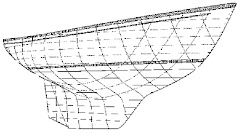Page down a couple of times to skip excruciating detail and get back to cruising and food...
...and the electrical problems continue. At about 5:00 this morning, I was woken up by the sound of the engine RPMs falling sharply and then starting to race. Everyone came bolting out of their berths to try and figure out what was going on. It was Art's watch when the problem started – the tachometer RPMs had suddenly gone way down, and to get them up into a normal range (2200) on the meter he'd opened the throttle. The RPMs on the tac looked right at this point, but the engine was clearly turning faster than that, as our speed through the water was ~8 knots, when normally it would be somewhere around six. Since we had adjusted the clamp on the throttle cable yesterday, our initial thought was that maybe it had worked itself loose and was allowing the cable to slip, but that didn't really jibe with how the engine was sounding. For some reason, I thought to check the voltage on the engine battery -- yikes, 5 volts. That's not good (it should be slightly north of 12 volts). Obviously it wasn't getting a charge. However, we'd been motoring steadily since noon the previous day, so what on earth had sucked the charge out of it? Maybe the cockpit panel? That would explain why the tachometer had dropped – it wasn't that the engine was running more slowly, it was just that the tachometer didn't have enough poop (i.e. voltage, for you technical types) to push the needle over to the actual RPMs on the engine. But shouldn't the alternator be charging both the engine and house batteries? One would think so, but it was fairly evident that for some reason, it was not. We know for sure that the battery charger we use for shore power charges up the engine battery – if it didn't we'd have never gotten off the dock at Newport the previous day. So went go to fire up the genset, which can also power that charger, but, duh, it starts off of the same dead battery as the engine. Luckily, our electrical system is set up with two places to parallel the house batteries with the start battery, so we flipped one of those switches and got the genset and smart charger going with the house batteries. However, running the genset for the remainder of the trip was, in addition to making it insanely noisy down below when the main is running and only somewhat less bothersome when we're sailing, was going to have us going through diesel like Grant through Richmond, and so would have been pretty suboptimal.
Remember how a couple of days ago we “lost” our inverter? That was probably the first sign of this problem. The regulator can only send power to the start battery (via an echo charger, we're assuming – one of the upshots of this experience is that even after owning this boat for 11 years, we don't really know enough about our electrical system) if the house bank is over a certain voltage. However, it appears that when we switched from gel cells to AGMs about a year ago, we set the regulator too low, which meant a) we were taking a lot longer than we needed to to charge the house bank from the alternator, and b) we were never reaching the threshold where the echo charger kicks in to charge the start battery. When we had the inverter problem, we hadn't run the genset for a couple of days, so the start battery wasn't getting charged. We think the inverter (integral to the charger) saw the low voltage on the start battery when we turned it on, and started trying to up the voltage on the house batteries so that they would reach the threshold needed to charge the start batteries, or something like that. Obviously, you're not supposed to let your 12 volt starting battery get down to 5 volts. Hopefully, it wasn't that low for very long and will be able to hold a charge going forward.
Today, the lights on the regulator were back working again, presumably because by using the charger powered by the genset we'd gotten the house voltage high enough to charge the start battery. At least that's the theory. Not wanting to start fooling around with the voltage settings on the regulator at sea, we're just leaving the engine and start batteries in parallel any time we have the engine on – that way both banks charge at the same time. That's the theory, anyway, with much thanks to our crew Mitch, who knows enough about this stuff to both make an educated guess as to what the problem was and to figure out a way around it. That was just a wee bit too much in the excitement department before 9:00 AM. However, the cheese grits with bacon we had afterwards for a late breakfast were pretty awesome.
How did we not notice this charging issue in the year plus since we adjusted the regulator? Easy. We usually run the genset at least once or twice a day to charge the batteries, make hot water, etc. when we're at anchor. We'd also usually run the charger, not because we particularly needed to, but because diesel engines like to run under load. That was apparently plenty to keep the engine battery topped off. We'd also only have the cockpit panel live overnight, to run the anchor light. When we were at the dock, we had shore power running the charger, which also charges both battery banks. A extended period with a lot of things running off the cockpit panel and pretty minimal genset use was, we think, the only set of circumstances in which this could happen, and pretty well describes the last couple of days. I'm just glad it happened now – if we hadn't had Mitch aboard, it would have taken us a really long time to figure out what was going on, so that's the silver lining to this whole thing.
This afternoon, we had a dolphin show – for about 10 minutes, 4 of them were playing in our bow wave, crisscrossing under the boat amidships and just generally having fun with each other and our boat. I'd never thought of Arione as a piece of playground equipment, but they sure did. It was really cool. I tried to get a picture, but without going into video mode on the camera (which I didn't think at the time of doing) it was impossible to time a shot for when they were visible. If we get another show, I'll try shooting video and capturing stills from that.
We're expecting to be back in the Bay Area later this week (Wednesday, with any luck), and Art has already set it up with KKMI for Ron Romaine (who originally designed and installed most of our electrical system) to go through all things electrical and put it all to rights. Whew.
Meatloaf, fried potatoes and broccoli were dinner. Everything except the meatloaf (which we all agreed to save the leftovers of for sandwiches tomorrow ) got finished off.
Fried potatoes
1 can of whole small potatoes (you could obviously use new potatoes that you'd peeled and boiled, but the canned ones are good, and last almost indefinitely)
Butter for frying them
Salt
Pepper
Smoked paprika
Garlic granules (obviously fresh would be fine here too)
Drain the potatoes, sprinkle salt, pepper and garlic granules on them and toss them around. I do this right in the can to save a dish that will need washing later.
Heat the butter in a frying pan on high heat until it's almost smoking.
Dump in the seasoned potatoes and turn the heat down to medium.
You'll want to disturb them as little as possible. You want them nice and crusty, and if you move them around too much, they disintegrate and turn into hash browns, which are good, but presumably not what you're going for here.
When they look good and crusty (maybe 20 minutes total), sprinkle them with smoked paprika. I use maybe 1/2 a teaspoon per can.
Put a lid on the pot and turn off the heat. They will hold for a good 20 minutes.
Just before serving, flip them around with a spatula to more or less evenly distribute the paprika.
Eat.




2 comments:
Sorry your alternator went poopie on you. the systems are probably the same as we have on the RV, though you could have a more primitive converter/charger. Basically, current technology is three stage:Bulk, Absorption, and Float. Bulk dumps as many amps into the battery as it will take (14+ Volts, increasing w/ battery voltage), and this will get you up to 90% capacity. Absorption willrun at whatever voltage the battery will, uh, absorb to finish the charge, and float will run 13.5 - 13.8V to keep them topped off. going felow 50% on the batteries does not-so-good things to their life. Assuming you have deep-cycle batteries, it won't kill them, fortunately, but expect worse performance. If you are charging via inverter/charger, consider getting a three-stage unit (I have a progressive dynamics 80 amp smart charger for 4x 6V 220AH house batteries. This unit will top off the batteries pronto (3hours or so from 75% charge). Some background on 12V systems in RV's can be found here: http://www.marxrv.com/12volt/12volt.htm
Glad your trip is going well and that noone urp'd in the rough conditions.
Yeah, we have a three stage charger/inverter (2 of the chargers, actually) and a three stage regulator for the alternator. It turned out that it was most likely user error on the regulator - we;ll confirm that Monday when we go see Ron.
It is a deep cycle battery, but since it's the start battery, we don't deeply cycle it,so any damage we've done will likely be fairly unnoticeable.
Post a Comment